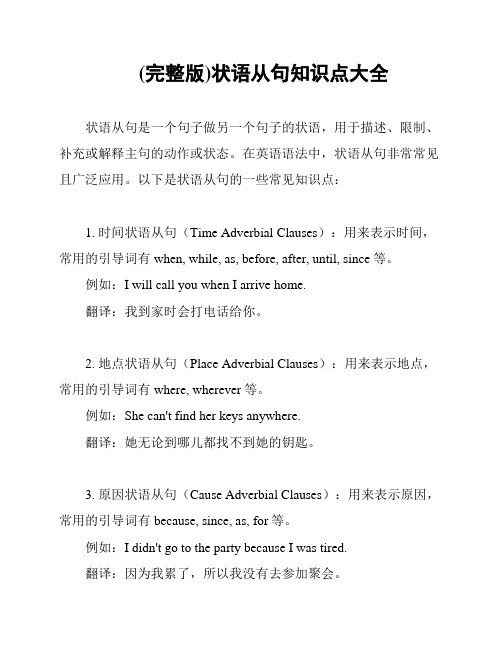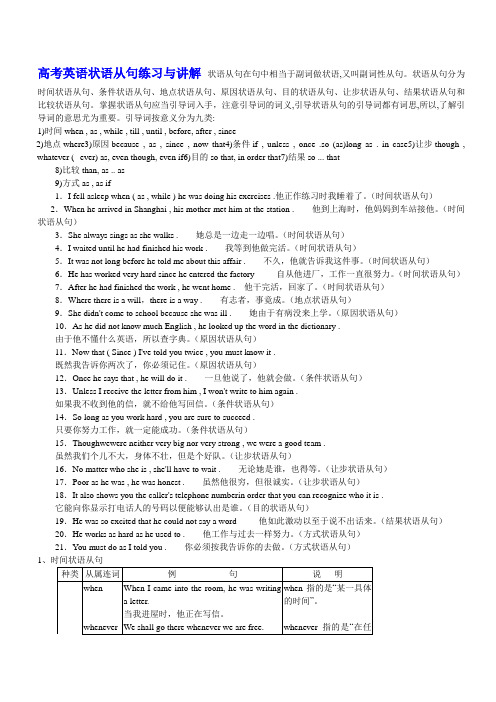(完整)高中状语从句讲解
- 格式:docx
- 大小:41.14 KB
- 文档页数:11

状语从句的讲解就是用一句话作状语分为:时间,地点,方式,原因,结果,条件,让步,目的,比较一、时间状语从句第一次见到你一见到你我就喜欢上了你直到见到你五岁时见到你When, as, while, before, after, since, till/until, as soon as no sooner…than…scarcely…when…hardly…when… the minute the second the instant the moment by the time 截止 immediately instantly directlyeach time every time next time the first time on doing sthwhenwhile 当…时as1。
when 1)当…时/ 延续性动词短暂性动词都可用2)这时/3)届时、到时I was watching TV when my cellphone suddenly rang这时When I was five years old I could speak five languagesThe wet weather will continue tommorow when a cold front is expected to arrive届时到时注意:时间状语从句中动作发生有前后时先发生的用过去完成时When my mother came back I had already gone to bed.2。
while 1)从句动词延续性2)同时发生3)对比的意味“然而”4)趁着He taught himself while he worked in a bank 延续性动词当他在银行上班时While we were working they were having a rest.对比While they were having a discussion , they got very confused。

高中英语状语从句讲解与练习高中英语状语从句一、时间状语从句1、when的用法(1)when既可引导一个持续性动作,也可引导一个短暂性动作,可用于表示主句和从句动作同时发生或从句动作先于主句动作,有时还可表示从句动作后于主句,意为“当……时候”。
(2)when在beabouttodo……when……,bedoing……when……,haddone……when……,beonone’sway……when……,beonthepointofdoing…when……等结构中作“那时突然”讲。
(3)when“既然、鉴于;尽管,虽然(位于主句之后);如果”2、while的用法(1)则表示“当……时候”,鼓励的动作必须就是延续性的。
(2)用做同列连词,则表示相对关系“然而”。
(3)引导让步状语从句,相当于although,意为“虽然”,位于主句前。
(4)引导条件状语从句,相当于as/solongas,意为“只要”。
3、as的用法(1)则表示“当……时候”,特别强调同时出现,不所指先后。
(2)说明两种正在发展或变化的情况,表示“随着”,表示时间的推移。
(3)表示“一边……一边……”(4)强调两个动作紧接着发生。
(5)表示“虽然,尽管”(6)其他含义“正像,正如”,“做为”,“由于,因为”。
4、before的用法(1)一般意为“在……之前”“……才”,“……就”“还没有……”“免得”“不知不觉”“宁可,宁愿”,“否则,要不然”。
(2)itwillbe/was时间段before通常现在时/通常过去时。
在肯定句中,意为“多长时间之后才”;在否定句中,意为“用没法多长时间就”。
5、until和till(1)与肯定句连用,必须是延续性动词。
(2)与否定句属格,必须不为延续性动词,则表示“直至……才,在……之前不……”。
特别注意:notuntil可以用作特别强调句和倒装句强调句:itis/wasnotuntil…that…倒装句:notuntil放句首时,主句要部分倒装。

(完整版)状语从句知识点大全状语从句是一个句子做另一个句子的状语,用于描述、限制、补充或解释主句的动作或状态。
在英语语法中,状语从句非常常见且广泛应用。
以下是状语从句的一些常见知识点:1. 时间状语从句(Time Adverbial Clauses):用来表示时间,常用的引导词有when, while, as, before, after, until, since等。
例如:I will call you when I arrive home.翻译:我到家时会打电话给你。
2. 地点状语从句(Place Adverbial Clauses):用来表示地点,常用的引导词有where, wherever等。
例如:She can't find her keys anywhere.翻译:她无论到哪儿都找不到她的钥匙。
3. 原因状语从句(Cause Adverbial Clauses):用来表示原因,常用的引导词有because, since, as, for等。
例如:I didn't go to the party because I was tired.翻译:因为我累了,所以我没有去参加聚会。
4. 结果状语从句(Result Adverbial Clauses):用来表示结果,常用的引导词有so, therefore, thus等。
例如:He studied hard, so he passed the exam.翻译:他努力研究,所以他通过了考试。
5. 条件状语从句(Condition Adverbial Clauses):用来表示条件,常用的引导词有if, unless, provided that等。
例如:If it rains tomorrow, we won't go to the park.翻译:如果明天下雨,我们不会去公园。
6. 目的状语从句(Purpose Adverbial Clauses):用来表示目的,常用的引导词有so that, in order that等。

完整版)高中状语从句归纳状语从句是在句子中做状语的,包括时间、条件、让步、原因、目的、结果、比较、地点、方式状语从句。
时间状语从句可以由when、as、while、until、not…until、before、after、since、the minute、the moment、each (every。
next。
the first) time等引导。
在时间状语从句中,一般使用一般现在时或一般过去时来表达。
1.时间状语从句引导词当句子中有时间状语从句时,可以用when、as、while、until、not…until、before、after、since、the minute、the moment、each (every。
next。
the first) time等来引导。
这些引导词在句子中的使用有不同的侧重点和用法。
1.1 when当我们用when引导时间状语从句时,它的主语和主句的主语相同。
如果从句的谓语动词是be动词,那么从句的主语和be可以省略。
例如:When I arrived home。
I had a little rest.1.2 asas不仅可以表示“当。
的时候”,还可以表示“一面。
一面”和“随着”的意思。
例如:XXX(一面。
一面)You will XXX(随着)1.3 whileXXX表示“当。
的时候”,强调主句的动作和从句的动作同时发生。
从句一般使用进行时,动词必须是延续性动词。
例如:While we were working。
they were having a rest.While they were having a n。
they got very confused.注意:while也有对比的含义,可以解释为“然而”。
例如:XXX。
XXX.2.until和not。
untiluntil和not。
until都表示“直到。
才”。
在肯定句中,主句常用延续性动词;在否定句中,主句常用短暂性动词。


高考英语状语从句练习与讲解状语从句在句中相当于副词做状语,又叫副词性从句。
状语从句分为时间状语从句、条件状语从句、地点状语从句、原因状语从句、目的状语从句、让步状语从句、结果状语从句和比较状语从句。
掌握状语从句应当引导词入手,注意引导词的词义,引导状语从句的引导词都有词思,所以,了解引导词的意思尤为重要。
引导词按意义分为九类:1)时间when , as , while , till , until , before, after , since2)地点where3)原因because , as , since , now that4)条件if , unless , once .so (as)long as . in case5)让步though , whatever (--ever) as, even though, even if6)目的so that, in order that7)结果so ... that8)比较than, as .. as9)方式as , as if1.I fell asleep when ( as , while ) he was doing his exercises .他正作练习时我睡着了。
(时间状语从句)2.When he arrived in Shanghai , his mother met him at the station .他到上海时,他妈妈到车站接他。
(时间状语从句)3.She always sings as she walks .她总是一边走一边唱。
(时间状语从句)4.I waited until he had finished his work .我等到他做完活。
(时间状语从句)5.It was not long before he told me about this affair .不久,他就告诉我这件事。
(时间状语从句)6.He has worked very hard since he entered the factory 自从他进厂,工作一直很努力。
高中英语状语从句用法详解内容提要:一、时间状语从句二、地点状语从句三、方式状语从句四、水平状语从句五、缘由状语从句六、结果状语从句七、目的状语从句八、条件状语从句九、退让状语从句十、比拟状语从句一、时间状语从句:1、时间状语从句通常用以下附属连词来引导:after, before, as, once, till, until, (ever) since, when, whenever, while, now (that), as long as, as soon as。
如:Now (that)you’ve grown up, you must stop this childish behaviour. Whenever we met with difficulties, they came to help us.Come and see us whenever you have time.People do not know the value of health till they lose it.2、有些词,如immediately, directly, instantly 等,当用于as soon as 意义时,也可以引导时间状语从句,如:I got in touch with him immediately I received his letter.My sister came directly she got my message.The machine will start instantly you press the button.I’ll telephone you directly I hear the news.Will you look for it immediately you get there?3.某些表示时间的名词词组,如the (very) moment ( = as soon as ), the minute ( = as soon as ), the instant ( = as soon as ), the day, the year, the morning, every time, each time, next time, the first time 等,也可以引导时间状语从句,如:I’ll tell you about it the moment you come.I started the instant I heard the report.The instant she saw him she knew he was her brother.Every time I catch a cold, I have pain in my back.I’m going to see him next time he comes to Shenzhen.He left Europe the year World WarⅡbroke out.He had impressed me that way the first time I met him.I started the very moment I got your letter.I’ll tell him the minute (that) he gets here.4.有些关联附属连词,如no sooner …than / hardly …when / scarcely …when / barely …when 等,也能引导时间状语从句。
高中英语34种状语从句句型讲解_1. 由as引导的非限定性的定语从句。
如:As we have known, he is a most good student.众所周知,他是个很好的学生。
请比较:It is well-known that he is a most good student.(前一个是定语从句,而后者是个主语从句。
)2. 由which引导的非限定性的定语从句。
如:He is a professor, which I have been looking forward to becoming. 他是个教授,那是我一直盼望的职业。
(因为先行词professor是表示职业的名词,因此引导词用which,而不用who。
3. 由where, when引导的定语从句(其中包括限定性的或非限定性的。
)如:This is the house where I used to come.请比较:This is the house which / that I used to come to.This is the day when I joined the Party.请比较:This is the day which / that I joined the Party on.(说明:关于that与which之间的区别,请看关系代词that和which的区别。
)三、让步状语从句4. No matter what / which / who / where / when / whose+从句,+主句.(注意从句中的时态一般情况下用一般现在时态。
)如:No matter what you do, you must do it well.请比较:Whatever you do, you must do it well. 无论你做什么,一定要做好。
No matter where you go, please let me know.请比较:Wherever you go, please let me know.你无论去哪儿,请通知我。
状语从句知识点归纳高三高三阶段是学生为了参加高考而奋斗的关键时期。
语法知识对于学生的语言表达和写作能力至关重要。
状语从句是一个常见的语法结构,也是高三学生需要掌握和运用的知识点之一。
本文将对状语从句的定义、分类以及常见的用法进行归纳总结,帮助高三学生更好地应对语法考试和提升语言表达能力。
一、状语从句的定义状语从句是一个句子,在句中充当状语,用来修饰谓语动词、形容词、副词或整个句子。
状语从句通常由连词引导,包括时间、地点、原因、条件、目的、方式等多种类型。
二、状语从句的分类和特点1. 时间状语从句时间状语从句用来表示动作或事件发生的时间,常见的引导词有when、while、as、since、until等。
例如:- She was reading a book when I saw her.- They have been friends since they were in kindergarten.2. 地点状语从句地点状语从句用来表示动作发生的地点或者某个动作的方向,常见的引导词有where、wherever等。
例如:- He will go wherever his parents go.3. 原因状语从句原因状语从句用来表示某个动作或者事件的原因,常见的引导词有because、since、as等。
例如:- He failed the exam because he didn't study hard.4. 条件状语从句条件状语从句用来表示某个动作的发生或者某件事情的成立条件,常见的引导词有if、unless、as long as等。
例如:- If it rains tomorrow, we will stay at home.5. 目的状语从句目的状语从句用来表示某个动作或者事件的目的,常见的引导词有so that、in order that等。
例如:- We study hard so that we can pass the exam.6. 方式状语从句方式状语从句用来表示某个动作或者事件的方式,常见的引导词有as、as if等。
高中英语状语从句讲解状语从句在句中作状语,修饰主句中的动词、形容词或副词等。
状语从句放在主句之前时,常用逗号分开:放在主句之后,一般不用逗号。
状语从句按其意文和作用可分为时间、条件、原因、让步、目的、结果、方式、比较、地点等九种。
1.时间状语从句时间状语从句常用连词有when,as,while,before,after,since,till(until),as soon as,hardly…when…,no sooner…than,the moment等。
时间状语从句一般不用将来时,因此,主句若为将来时,时间状语从句要用一般现在时。
如:I'll go on with the work when I come back tomorrow.⏹when, while与as的异同作为从属连词,三者的意思都是“当…时候”,在用法上有如下异同点。
1.在主句的谓语动词表示短暂动作,而从句说的是一段时间发生的动作时,三个连词都可以。
如:I met him as/when/while I was doing some shopping.2.从句动作发生的时间如果是某一点,而且主句动作同时或几乎同时发生时,不能用while,而只能用when或as。
如:I met him as/when I was getting off the bus.3.当从句动作发生在主句动作之前时,只能用when,如:I will ring you up when I return.4.主句用进行时态,从句动作发生的时间如果是某一点,只能用when。
如:My mother was cooking the supper when I got home.5.如果主句和从句的动作都在一段时间发生,可用as或while,只不过as强调主句和从句中的动作同时发生,而while强调主句的动作延续于while所指的整个时间。
As I put on my coat,something fell out of the pocket onto the floor.While he was in prison,Joe Hill continued to write songs to keep up the worker's fight.⏹when的从属连词用法when作为从属连词引导时间状语从句,既可放在主句之前,也可放在主句之后。
语法专题复习(四)状语从句讲解状语从句指句子用作状语时,起副词作用的句子。
它可以修饰谓语、非谓语动词、定语、状语或整个句子。
一般可分为九大类,分别表示时间、地点、原因、目的、结果、条件、让步、比较和方式。
尽管种类较多,但由于状语从句与汉语结构和用法相似,所以理解和掌握它并不难。
状语从句的关键是要掌握引导不同状语从句的常用连接词和特殊的连接词即考点。
现分别列举如下: 1.I fell asleep when he was doing his exercises .他正作练习时我睡着了。
(时间状语从句)3.She always singsa s she walks . 她总是一边走一边唱。
(时间状语从句)4.I waited until he had finished his work . 我等到他做完活。
(时间状语从句)5.It was not long before he told me about this affair . 不久,他就告诉我这件事。
(时间状语从句)6.He has worked very hards ince he entered the factory 自从他进厂,工作一直很努力。
(时间状语从句)1.时间状语从句常用引导词:when, as, while, as soon as, while, before, after, since , till, until 特殊引导词:the minute, the moment, the second, every time, the day,the ins tant, immediately , directly, no sooner ⋯than, hardly ⋯when, scarcely ⋯wh en2.地点状语从句常用引导词:where 特殊引导词:wherever, anywhere, everywhere3.原因状语从句常用引导词:because, since, as, since特殊引导词:seeing that, now that, in that, considering that, given that, conside ring that,4.目的状语从句常用引导词:so that, in order that特殊引导词:lest, in case, for fear that,in the hope that, for the purpose that, to the end that5.结果状语从句常用引导词:so ⋯that, such ⋯that,特殊引导词:such that, to the degree that, to the extent that, to such a degree that,6.条件状语从句常用引导词:if, unless, 特殊引导词:as/so long as, only if, providing/provided that, suppose that, in ca se that, on condition that7.让步状语从句常用引导词:though, although, even if, even though特殊引导词:as(用在让步状语从句中必须要倒装),while ( 一般用在句首),n o matter ⋯,in spite of the fact that, while, whatever, whoever, wherever, wh enever, however, whichever8.比较状语从句常用引导as (同级比较 ), than (不同程度的比较 )特殊引导the more ⋯ the more ⋯ ; just as ⋯, so ⋯; A isas X is to; no ⋯ more than; not A so much as Bas ⋯asMary is as old as my sister.连词表示同程度级的比比玛利和我姐姐一样大。
较,肯定句用 as ⋯as 否not so/as He doesn 't run so (as) fast as Jack 定句可用 not as as 或较⋯as 他不如杰克跑得那样快。
not so ⋯asthe same His book is the same as mine.状⋯as 他的书和我的一样。
such ⋯asHenry is not such a good worker asPeter .语享利这个工人不如彼得那样好。
thanShe has made greater progress this year than表示不同程度之比较, 从she did last year.主句中用比较级的形容她今年比去年进步更大。
词或副词。
句He bought fewer books than I (did).他买的书比我买的少。
The more you read, the better you understand. 你看的书越多,你懂得的就越多。
The more tickets you sell, the more money you will get. 你卖的票越多,你的收入也越多。
The harder you work, the greater progresswhich, No matter who takes up the matter for me ,I shall be very grateful. 不管谁为我处理这件事,我都将非常感激。
主句后。
how ⋯)wh - ever Whatever happens / may happen , we shall not lose heart. 无论发生什么,我们都不要失去信心。
Whoever comes, he will be welcome. 无论谁来,都会受到欢迎。
wh - ever 从句中的动 词有时可以和 may 连用。
判断 wh - ever 引导 的是状语从句还是名词 性从句的一点是,名词 性从句,主句中一定有 一个成分要在从句担 任,一般从句与主句之 间没有逗号。
不可将 no matter 与 wh — ever 连用(whatever whoever whenever whicheve r however)从句 the more ⋯the the more ⋯ the more 意 思为越⋯越⋯ ,通常的 语序为从句在前主句在 后,这两个 the都是表 示程度的副词,用在比 较级的形容词或副词前 面。
9. 方式状语从句 常用引导词: as, as if, how 特殊引导词: the way10 特殊的状语从句的简化状语从句的省略状语从句同时具备下列两个条件 :①主句和从句的主语一 致,或从句主语为 it ;②从 句主要动词是 be 的某种形式。
从句中的主语和 be 动词常可省略。
例如:When ( the museum is ) completed , the museum will be open to theas 译为,按照或 如或 as though 的 和用法基本一样。
中可以用现在时表 能符合事实,也可 虚拟语气。
public next year .He' ll go to the seaside for his holiday if (it is ) possible.另外,比较状语从句经常省略。
例如:I ' mta ller than he (is tall ).The higher the temperature (is), the greater the pressure (is ).状语从句的 "简化 "现象常存在于以下五种状语从句中 :由if, unless 等引导的条件状语从句;②由although, though, even if / though 等引导的让步状语从句;③由when, while, as, before, after, until / till 等引导的时间状语从句;④由as, as if 等引导的方式状语从句;⑤由as, than 等引导的比较状语从句。
下面针对这五种情形作一归纳。
If (it is) possible , he will help you out of the difficulty. 如果可能的话,他会帮你摆脱困境。
You must attend the meeting unless (it is) inconvenient to you. 除非情况对你来说不方便,否则你必须出席这次会议。
As (he was) young, he learned how to ride a bike他. 小时候就学会了骑自行车。
Whenever (she is) free, she often goes shoppin她g.有空就去逛商店。
Work hard when (you are) young, or you'll regret少. 壮不努力,老大徒伤悲。
While (he was) a you ng boy, he was always ready to help others 他. 在孩提时代就乐于助人。
Although (he is) doing his best in maths these days, he hasstill got no good marks. 尽管近来他一直在学数学,但他仍然没有取得好成绩。
d.连词+过去分词The concert was a great success than (it was) expected这. 场音乐会出乎意料地取得了巨大成功。
He stood up as if (he were) to say something当. 时他站起来好像要说什He wouldn't solve the problem even if (he were) to take charge.即使他来负责,他也解决不了这个问题。
f. 连词+介词短语She looked anxious as though (she was) in trouble.她看上去很焦急,好像遇到了麻烦。
He had mastered the English language before (he was) in the USA.他到美国之前就懂英语了。
tips:只用as 不用when 或while 的情况1、用于表示同一个人的两种动作交替进行,指“一边⋯一边⋯”,如:The girl sings as she goes to school.2、表示两个同步发生的动作或行为如:As time went by,she became more and more beautiful.3、表示两个动作紧跟着发生,如:As he was going out,it began to rain,4、接在名词后面表示某一个年龄段时。